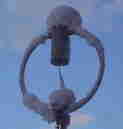
Building a small transmitting loop(Magnetic Loop)

Building a small transmitting loop(Magnetic Loop)
Junk box loops are do-able certainly, but need justthat bit more attention to the quality of connections if they areto be effective radiators. The essential point to remember isthat the radiation resistance of a magloop is very low.
Rr is a concept rather than something real - whereas when youfeed energy into an antenna, some of it is lost as heat acrossthe actual resistance of the antenna, the energy that is radiatedis said to have been dissipated across the radiation resistance.
Clearly if Rr is low, then the actual resistance must be keptvery low indeed so that it does not dissipate most of the inputpower as heat. Use single pieces of conductor with as few jointsas possible, and the largest diameter hollow conductor practicalto minimise losses (hollow because that saves weight and cost,and the RF only travels just below the skin of the conductoranyway).
The calculations can be done with pen and paper, a calculator,or increasingly with computer spreadsheets and dedicated programs.The calculations that you need concern the diameter of the mainconductor, the capacitance and voltage rating of the tuningcapacitor and the size and position of the inductive feed loop -unless you are tapping the feeder directly onto the loop.Efficiency and bandwidth are often revealed too.
'Q' or the measure of 'goodness' of a tuned circuit is one ofthe more tricky parts of the calculation. It is best measuredwith the completed antenna in place rather than calculatedbecause it is so dependent on surroundings such as feed point andproximity to earth.
Reg G4FGQ has written a number of loop designprograms that are freeware and available for download here, butsome of the formulae used are detailed here
For those of you who want to write your own programs, perhaps forthe smaller and older computers available there is a 
If you want to model the efficiency, radiation resistance,capacitor voltages and sizes of an example magnetic loop (actuallybuilt in copper) the following early version Lotus 123 compatiblespreadsheet gives you 'ball-park' figures that are really quiteenlightening.
By way of example, I have an 180cm diameter loop for 80-30metresmounted about fifteen centimetres from the ground, against abrick wall - with a tree on the other side of it a mere thirtymetres from the shack.
A smaller (80cm) loop covers 20-10metres and is mounted on analuminium stub about a metre above a flat roof which is itselfmuch lower than the surrounding buildings.
A have a similarly sized 80cm loop for 50MHz too, the loop ismade from narrow bore copper pipe (the sort used for centralheating installations) which bends easily - and has a 10pFvariable air spaced variable capacitor that stays on about 50.140MHzand gives a bandwidth of about +/- 60kHz which is very usable onCW and SSB. 7pF tunes around 50Mhz and the same loop tunes downto 4m at a capacitance of about 2 pF.
Drawn on a Psion series 3a palmtop using VECTOR by
The 50MHz loop built from narrow bore easily bent 10mm diametercopper tubing - comes in a coil already! The loop is fastened toa 20mm diameter conduit pipe made of a sturdy plastic. The loopis attached at the upper edge (open ends) and on its lower edgeusing the same clips that normally run it along the skirtingboard.
If you motorise the tuning capacitor -which is necessary if youusing the loop on anything but a spot frequency - although thebandwidth is around a 100kHz on 6m - the control line whichcarries the power to the motor should run down the midpoint ofthe main loop, so as to minimise eddy currents being induced init.
For portable or mobile work a small aluminium stub on the carrack accepts the 20mm diameter plastic conduit that supports theloop tuning capacitor and (at the lower end) the coax feed loop.
During a sunny spell I sat in the garden and worked a stationin Finland with the loop on a 12ft glass fibre mast purchasedfrom a radio rally- seen here co-mounted with a 2m HB9CV. The non-VHFnature of this QTH is detailed elsewhere and this was just before50MHz opened up for the summer....so it felt better than itsounds..
Amateurs have never followed rules! As high as possible and asfar away from anything else as possible is a nice, but oftenunrealistic ideal. STLs do not like being near any conductors,because the magnetic flux is drawn to them, and induces wastefulcurrents that in turn produce unhelpful heat. The centreconductor that might support your loop is no exception, but solong as it is exactly central, the induced currents largelycancel out. Current will flow on the braid of the feeder if theSTL (and feeder when nearby) is not symmetrical about it'scapacitor for the same reason. The radiating ability of theantenna correlates with the area within the tuned loop - andsince for a given length of conductor, a circle produces thebiggest area AND circles can be free from lossy joints - you willless often see square STLs - although they exist.
Magnetic fields decay with distance faster than electricalfields- although at about 1/6 of a wavelength from the loop theyare about equal intensity. However closer up, they are morepenetrative.
STLs may therefore be more tolerant of unavoidable low levelmounting than wire antennas, but by the same token, a smallelevation of an STL can have a significant benefit.
Magnetic loops are fed with unbalanced co-axial feeder. Until themain capacitor is tuned to the correct transmit frequency theantenna will not resonate, and cannot be loaded properly. Oncetuned however, the smaller loop used to load the antenna thenneeds to be positioned to effect a 50 ohm (or 75?) match with thecoaxial cable being used. Any mismatch here will result instanding waves on the coaxial cable, which in turn will radiateand reduce one of the advantages of a magnetic loop - its narrowbandpass filter effect.
Happily, once you have a loop tuned, and then position theinductive driver loop to get a 50ohm match, you can retune thetransmitter and main loop without having to worry about alteringthe loading loop - the 50ohm match works for all resonantfrequencies without further adjustment.
How to get the RF into the antenna? There are three potentialways. All the pictures on this site show the usual method whichinvolves terminating the feeder co-axial cable with a loop roundto the braid. This loop inductively couples with the larger tunedloop -using air as a dialectric. It has been customary topartially screen this loop by stripping the braid only half wayaround it and joining braid to central conductor at the top ofthe loop- leaving half the small loop as a single conductor tojoin the braid of the feeder. Some people feel that this offersbetter screening from electrostatic noise, others do it simply tomake the smaller loop that bit stronger.
The second method involves directly tapping the braid of thefeeder coax to ther main loop exactly opposite the capacitor.This is to keep the braid as electrically neutral as possible.The centre conductor is then tapped onto the big loop to one sideof the braid connection point - adjusting for a 50 ohm match oncethe main coil is resonant on the transmit frequency. It isn'tthat easy to get a good connection with copper pipe however. Thethird method is to use a split capacitor, and whereas the methodabove taps onto the inductive part of the tuned loop, you canpotentially tap onto the capacitor. It is however very complex todo, and more of a theoretical idea, than a practical one.
Carl GW0TQM's Magnetic loop page
Contributions comments and STL links welcomed.